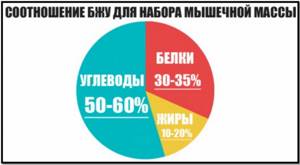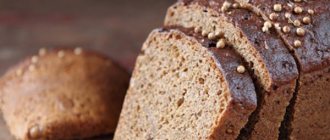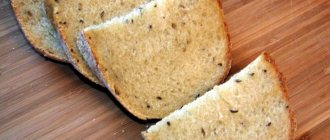Slow or complex carbohydrates (English: Slow Carbohydrates or Complex Carbs) are foods with a glycemic index of less than 50 units.
Carbohydrates are a class of energy-rich compounds that provide the body with the necessary resource for activity. Without these substances, neither muscle contraction, nor the conduction of impulses along nerve fibers, nor the functioning of the brain is possible.
Carbohydrates are divided into several groups:
- Fast or simple carbohydrates . They are processed in one stage, increase the level of glucose in the blood, and in a matter of minutes provide the body with the necessary nutrition and energy. This includes both pure glucose and sugar, and confectionery products based on them.
- Slow or complex carbohydrates. They are more difficult to process and take longer to process. They put less stress on the body.
For convenience, a better understanding of the difference between substances, and calculations, a formal criterion for the separation of carbohydrates has been developed - the so-called glycemic index.
Note! The glycemic index is the ability of a product to increase blood sugar levels. Pure glucose is taken as the basis, the starting point, whose glycemic index is 100 (a dimensionless value). The number is significant. Products with such a glycemic index lead to a jump in sugar levels in a matter of minutes, even in healthy people.
It is impossible to say which is better: simple or complex carbohydrates. It all depends on the characteristics of the diet, health status and goals that a person wants to achieve by changing his own menu and approach to nutrition.
Let us take a closer look at what the described compounds are.
Simple and complex (fast and slow) carbohydrates
According to their chemical structure, types of carbohydrates are simple (mono- and disaccharides) and complex (polysaccharides). The energy value of 1 gram is equal to 4 kilocalories.
Recently, for instant satiation, people have been using products containing simple carbohydrates - they are high in calories, but very tasty. Consequently, preference is given to fast and refined carbohydrates. This is of great interest among scientists who are actively studying human performance in accordance with the food consumed.
First you need to understand what simple and complex carbohydrates are in order to come to the right conclusion.
Simple (fast) carbohydrates
Based on their chemical composition, simple carbohydrates are divided into two types.
| Monosaccharides (simple sugars, one molecule) | Disaccharides (contains 2 monosaccharide molecules) |
|
Summarize
- Carbohydrates can play an important role in many health and fitness goals.
- Athletes and people who exercise multiple times a day can improve their performance by consuming carbohydrates before exercise and speed up recovery by consuming them after exercise.
- However, for the average person, time seems less important than choosing foods that contain high-quality complex carbohydrates and tracking your overall caloric intake.
Tags: carbohydrates
- Related Posts
- What is lactic acid fermentation and is it beneficial?
- 9 bitter foods that are good for your health
- 6 foods that cause inflammation in the human body
« Previous entry
Types of complex carbohydrates
Polysaccharides or long carbohydrates are large chains of compounds that, when broken down, can provide much more energy than simple ones. Complex carbohydrates are digested slowly and for a long time, without sudden spikes in insulin. After taking them, a person remains full for a long time, full of strength and vigor.
Fiber, starch and glycogen are complex carbohydrates. Each of them is an important component for building a harmonious diet, and ideally it should be a combination of all three types. Let's take a closer look at the features of each.
Starch is considered unique and the most valuable; about 80% comes from healthy carbohydrates from starchy foods. Compared to simple compounds, the product has longer chains consisting of glucose molecules. Similar polysaccharides are found in foods such as cereals, pasta and baked goods, rice and cereals, green beans and potatoes. There are also processed forms - these are short polymers of glucose and maltodextrin. They dissolve perfectly in water, which facilitates immediate entry into the bloodstream after administration.
This product has another big advantage - the absence of a side effect in the form of bloating. Complex compounds are recognized as the best sources of energy, so every athlete should add them to their diet.
Fiber – This substance is usually very neglected by many people. There is a lot of it in fruits and vegetables, legumes and grains, as well as nuts. Its structure is not a starchy polysaccharide, but in common parlance it is dietary fiber.
Has a number of features:
- there is no possibility of digesting fiber due to its resistance to digestive enzymes;
- reduces the risk of oncological pathologies of the colon, diabetes mellitus and diseases of the cardiovascular system;
- lowers levels of “bad” cholesterol;
- promotes the excretion of bile acid.

Fibers can be soluble or insoluble. Agree, not many people know which carbohydrates are insoluble in water and why they are needed. In the meantime, there are a number of advantages for athletes:
- The insoluble group helps improve the digestion process by slowing down the hydrolysis of starch, and also helps remove breakdown products and slow down the absorption of glucose.
- A group of soluble fibers slow down digestive activity and lower cholesterol levels. Like insoluble fiber, it slows down the absorption of glucose.
Glycogen - the chain contains several glucose molecules. Immediately after eating, glucose enters the bloodstream, the excess of which is stored in the form of glycogen. For example, during physical activity, glucose levels drop, the body begins to break down glycogen with the help of enzymes, returning glucose levels to normal. Even during the training process, all organs can produce energy in sufficient quantities.
Fiber and starch
These two components represent two types of difficult-to-digest carbohydrates. Fiber is especially important because it promotes bowel regulation and helps control cholesterol levels.
The main sources of dietary fiber are:
- fruits
- vegetables
- nuts
- beans
- whole grains
Starch is also found in some fiber foods. The difference is that some foods are considered more starchy than fibrous, such as potatoes.
Video
Other foods high in starch:
- whole wheat bread
- wheat
- corn
- oats
- peas
- rice
What complex carbohydrates are is the key to long-term health and weight loss. They make it easier to maintain your weight and may even help protect against type 2 diabetes and cardiovascular problems in the future.
Bodymaster.ru recommends Fitness Trainers:
The main places where glycogen accumulates are muscles and liver. The total amount varies in the range of 300-400 g. In the process of building the body, glycogen from muscle fibers is extremely important.
Under the influence of physical activity, fatigue occurs due to the depletion of stored glycogen. In this regard, one and a half to two hours before the start of training, you need to consume foods high in carbohydrates in order to replenish glycogen reserves.
The table provides specific examples of each type of long connection.
| Polysaccharides | ||
Starch:
| Soluble Fiber:
| Insoluble fiber:
|
A little about drinks
If you ask supporters of proper nutrition about drinking alcohol, a violent reaction will follow. There is no doubt that alcoholic drinks are harmful, but there is still one “but”. We are talking about wine, dry red wine. One glass at dinner will benefit everyone.
The drink contains complex carbohydrates, not much, but they are there. In addition, red wine stimulates metabolism, food is digested better and faster, sleep and blood circulation are normalized.

How does carbohydrate metabolism occur?
Food containing complex carbohydrates in the gastrointestinal tract can be broken down into simple compounds, namely glucose, after which it is absorbed into the blood. A hormone (insulin) is synthesized, which converts the product into glycogen. The process lasts until blood glucose levels stabilize.
Glycogen reserves are located in muscle fibers and liver cells. During training, reserves in the muscles are depleted, and reserves in the liver are aimed at maintaining the required level of glucose in the blood. The norm is considered to be from 80 to 120 mg/dl.

In case of a lack of nutrients, glycogen from the liver is converted back into glucose and enters the blood - all this is necessary to maintain the normal functioning of the body.
What happens when you have too many carbohydrates?
If complex carbohydrates enter the body in excess, this helps to increase insulin production, no matter what foods are consumed. Overload of the pancreas leads to depletion of its cells, which, if there is a tendency, can cause diabetes mellitus. A completely unpleasant bonus to everything will be the deposition of fat with an excessive concentration of glycogen.
When complex carbohydrates are consumed in excessive amounts and are poorly chewed, fermentation processes are started in the intestines. This is not only bloating and discomfort during training, but also poisoning the body with toxins from the intestines. In medicine this is called fermentative dyspepsia.
What happens when there is a lack of carbohydrates
If, when planning your diet, you strictly cut carbohydrates for a long time, this can lead to irreversible metabolic disorders. The body will not receive important energy from food, so it begins to waste glycogen from the liver, which provokes a disruption in its activity.
When there are no food sources of carbohydrates, the process of protein breakdown is activated to obtain the necessary energy. As a result, the destruction of muscle mass begins, which was built so long and diligently in the gym. It should be noted that the process also affects the heart muscle. All these factors make a long-term and grueling low-carb diet extremely detrimental to a person.

Low levels of glucose in the blood provoke exacerbation of hunger, and prolonged deficiency leads to weakness and lack of energy, nausea and sweating, headaches and systematic dizziness, tremors and tachycardia. This is called hypoglycemia, which is made worse by insulin resistance (metabolic syndrome).
Polysaccharides for weight loss
Many nutritionists don't use the word "bad" when describing foods because, as the saying goes, "there are no good or bad foods, only good or bad diets." With that said, carbohydrates that have a rapid rise in blood sugar levels are generally considered fast or light, while those that are absorbed slowly and have little effect on blood sugar are considered slow or heavy.
Please note: The glycemic index was created to measure the rate at which carbohydrates are converted into glucose. Fast-digesting foods have a high index, which ranges from 0 to 100, while “slow” foods have a lower index.
This is important because large spikes in insulin levels affect your hunger (can make you even hungrier), can negatively impact weight loss, and can even lead to diabetes if levels are chronically elevated from eating too much fast carbohydrates.
Clinical picture
Excessive consumption or deficiency of carbohydrates can be harmful to health. To maintain normal metabolism, you need to include at least 60% of a macronutrient in your diet every day.
What doctors say about losing weight
Nutritionists and trainers very often in practice are faced with the stereotype that in order to lose weight it is necessary to either critically reduce the amount of carbohydrates or give them up altogether. The root of the evil is the lack of information and a large number of false facts that can be read in popular communities. Such actions will not only weaken the immune system, but will also seriously undermine your health.
Experts also believe that in the process of losing excess weight, slow carbohydrates improve peristalsis and intestinal microflora. The component is also indispensable during muscle mass gain. Recipes for each purpose can be found at the end of the article.
Why are mono- and polysaccharides needed?
Carbohydrates perform the main function in our body - energy. The body synthesizes about 60% of energy thanks to poly- and monosaccharides. And only 40% comes from proteins and fats. Now do you understand how important these substances are?
Simple carbohydrates very quickly replenish lost energy. But it is also quickly consumed and the body requires supplements. To gain weight, your diet includes both simple and complex carbohydrates. They are also indispensable if you lead an active lifestyle. Polysaccharides or complex carbohydrates supply the body with energy slowly. You don't feel hungry longer.
The ratio of polysaccharides, monosaccharides and fiber in the diet should be 70% / 25% / 5%
Those. Most of all, you need to consume complex carbohydrates every day. Simple saccharides should make up 1/3 of the daily carbohydrate intake. For many, it’s the other way around: for a snack at work, we drink tea with buns and sweets. Hence the excess weight.
For those who want to lose weight, be sure to read my article - how many carbohydrates do you need per day when losing weight.
Where are complex (slow) carbohydrates found - list of products
We have already figured out what long-term carbohydrates are, and now let’s talk about which foods contain them the most.
The key rule of proper nutrition is that it is better to consume slow carbohydrates in the first half of the day, and this is due to the most successful time for their absorption. However, if the workout is planned for the evening, then there is nothing critical in eating foods that contain these macroelements for dinner. In the case when the main goal is weight loss, it is best to give preference to fiber, which quickly saturates and is not absorbed by the body. At the stage of gaining muscle mass, it is better to switch to ingredients rich in starch and glycogen, but you should not forget about protein foods either.

To make it easier for you to choose complex carbohydrates to achieve your goals, we have provided a table with the most popular ingredients in descending order of macronutrient amount.
| Product groups | Name | Amount of carbohydrates per 100 g |
| Whole grains | corn grits | 75 |
| Brown rice | 72,9 | |
| barley | 71,7 | |
| wheat | 69,3 | |
| buckwheat | 68 | |
| oats | 66,2 | |
| spelled | 61,2 | |
| quinoa | 57,2 | |
| Whole grain bread and pasta | durum pasta | 71,5 |
| wheat bread | 53,4 | |
| Rye bread | 49,8 | |
| Legumes | chickpeas | 61 |
| lentils | 60 | |
| beans | 52,7 | |
| green beans | 3,6 | |
| Nuts | cedar | 28,4 |
| cashew | 22,5 | |
| almond | 21,7 | |
| hazelnut | 9,4 | |
| walnut | 7 | |
| Milk products | yogurt 1.5% | 7,4 |
| milk 2.5% | 4,7 | |
| cottage cheese 1.8% | 3,3 | |
| Fruits and berries | banana | 21 |
| grape | 15,4 | |
| apple | 13,8 | |
| raspberries | 11,9 | |
| plum | 11,4 | |
| pear | 10,3 | |
| orange | 8,1 | |
| strawberry | 7,5 | |
| currant | 7,3 | |
| Vegetables | potato | 18,1 |
| carrot | 6,9 | |
| broccoli | 6,6 | |
| pumpkin | 6,5 | |
| cauliflower | 5,4 | |
| tomato | 3,7 | |
| cucumber | 2,8 |
Contents by groups, differences
As you have seen, complex carbohydrates are synthesized in various ingredients, and the following list of generalized foods reveals their main characteristics.
Vegetables and fruits are an indispensable and key component of a healthy diet for any person, regardless of the specifics of training. Vegetables and fruits contain complex compounds. To obtain the maximum amount of useful substances, it is recommended to consume them raw, because any method of heat treatment suppresses their numbers.

Greens - experts highly recommend including this ingredient in your menu, because... it can not only enrich it with useful substances, but also normalizes the processes of digestion and the excretory system.
It’s not for nothing that they say that porridge If they are prepared on the basis of whole grain cereals, which are classified as complex compounds, then this is the best option for daily nutrition. It is recommended to avoid highly processed products because... they have a high glycemic index and negatively affect the weight loss process. Displays the glycemic index, the level of blood glucose response to any product.
Dairy products contain lactose, which classifies these products as simple carbohydrates. But this does not mean that you need to abandon this source, because low-fat products still contain slow chains and are rich in calcium and phosphorus.
Legumes and grains are another great source of energy. You can significantly increase your intake of this macronutrient by replacing processed grains with legumes. Replacing wheat bread with a whole grain product can significantly increase your fiber intake.

Freshly squeezed juices are a liquid form of complex carbohydrates from fruits and vegetables, consumed in the form of drinks.
Sample menu
There are several types of carbohydrate diets.
Classic version
The classic type carbohydrate diet is designed for 2 weeks. At first, weight loss occurs, and then the result is consolidated. As a result, you can lose 6-8 kg. Below is an example of a menu for each day:
| Day of the week | Menu |
| Monday |
|
| Tuesday |
|
| Wednesday |
|
| Thursday |
|
| Friday |
|
| Saturday |
|
| Sunday |
|
Easy option
A light carbohydrate diet is used if the weight loss period will be long. During each week you can lose 1 - 2 kg, but the lost kilograms will not return.
With a light type of carbohydrate diet, you only need to give up white flour and sugar. The rest of the products can be eaten.
Strict version
A strict carbohydrate diet involves severe restrictions. It lasts a week, after which the normal diet gradually returns. It is advisable to limit sweets, fatty and floury foods even after leaving the diet. In a week you can lose up to 8 kg.
Menu for the week:
| Day of the week | What is allowed to eat per day? |
| Monday | 410 g oven-baked potatoes, some greens and 0.5 liters of kefir |
| Tuesday | 410 g cottage cheese and 0.5 l kefir |
| Wednesday | 410 g of any fruit and 0.5 l of fermented milk drink |
| Thursday | 410 g boiled chicken breast and 0.5 l fermented milk drink |
| Friday | Repeat Wednesday's diet, but choose other fruits or berries |
| Saturday | Fasting day. Only non-carbonated mineral water is allowed - 1.5 - 3 liters. Food is prohibited |
| Sunday | 410 g of any vegetables and 0.5 l of fermented milk drink |
Such a strict diet is allowed no more than once a month.
To build muscle mass
Men and women who are trying to get rid of body fat and at the same time build muscle mass through exercise can also benefit from a carbohydrate diet.

Before lunch, you should eat more food rich in carbohydrates, and in the afternoon - proteins. The course lasts approximately a month.
A sample menu for the day is as follows:
- Breakfast – buckwheat with mushrooms and 2 boiled eggs.
- Snack – cereal bar.
- Lunch – chicken breast baked with vegetables.
- Snack – banana and protein shake.
- Dinner – baked fish, salad with seafood and vegetables.
- Snack – cottage cheese with berries or a protein shake (casein).
Ectomorphs are recommended to consume as many carbohydrates as possible, both fast and slow types. You can also quickly gain muscle mass by drinking a high-carbohydrate gainer.
During pregnancy
If a representative of the fair sex is pregnant, then the diet should be balanced and varied so that the woman feels good and the fetus develops correctly. The specific gravity of proteins, fats and carbohydrates should be 25, 15 and 60%, respectively.
A sample daily menu for a pregnant woman is as follows:
- Breakfast - porridge of your choice (cook in water with milk - take both components in equal parts), 1 boiled egg, cheese, whole grain bread.
- Snack – cottage cheese with fruit.
- Lunch – borscht with sour cream, beef stew with vegetables.
- Snack – fruits or berries.
- Dinner – fish cooked in a steamer, salad with seafood.
- Snack: yogurt or kefir.
You should definitely consult your doctor first.
The benefits of complex carbohydrates
Excessive macronutrient content in the diet can negatively affect the health and fitness of an athlete, but its role is extremely important in the life of the body:
- The main source of energy - carbohydrate provides fuel for a full, productive workout. The daily requirement is calculated individually;
- after the reserves of glucose and glycogen are depleted, thanks to the slow chains of the macroelement, the consumption of protein as an energy source does not turn on. This phenomenon is called glycogenesis and occurs when blood glucose levels are low. Accompanied by the release of glucagon;
- prevents the process of catabolism and muscle atrophy, which leads to loss of muscle mass as a result of the process of glucogenesis;
- Another huge benefit from consuming healthy carbohydrates is that they can improve brain function and maintain the central nervous system in a normal state. Glycogen does not accumulate in the brain, therefore, on a low-carbohydrate diet, athletes often observe a decrease in mental activity, especially concentration;
- Eating nutritious meals with enough carbohydrates prevents hypoglycemia, the symptoms of which are: hunger, loss of energy, migraines and dizziness. To avoid experiencing such feelings during training, it is important to make sure that your diet meets the standards.

1 - Slow Carbs Are Less Likely to Cause Blood Sugar Spikes
Bad carbohydrates can significantly increase blood sugar levels, which forces the pancreas to produce a large dose of insulin. This not only returns the feeling of hunger, but also provokes you to eat another portion of sweet food. Complex types of carbohydrates take much longer to digest than simple carbohydrates, which helps maintain stable blood sugar levels, providing a boost of energy throughout the day and during the training process.
2 - Complex carbohydrates may reduce the risk of some chronic diseases
For a healthy and nutritious diet, it is important to eat foods containing complex carbohydrates, which will not only significantly reduce the risk of gaining excess weight, but will also help prevent the development of chronic diseases such as diabetes and cardiovascular pathologies. All sources of slow carbohydrates are rich in dietary fiber, vitamins and minerals, as well as antioxidants and plant compounds - this complex provides excellent prevention of diseases of various types.
It should be noted that many studies support the positive association between low levels of “bad” cholesterol and blood sugar with a diet that includes fiber from whole foods.
3 – Long-lasting carbohydrates promote a healthy digestive system
The human intestine contains a huge variety of “good” bacteria – these are microbiota. They promote healthy digestion, better absorption of minerals, neutralize inflammatory processes in the intestines, and also fight constipation. All foods containing complex carbohydrates contain large amounts of soluble fiber, which promotes the growth of beneficial bacteria by feeding them. The bacteria in turn produce short-chain fatty acids, which are extremely beneficial for the digestive system. If you feed them with the right macronutrients, you can forget about the craving for overeating, which is very important on a diet.
4 – Long Carbohydrates May Reduce Inflammation
Inflammation is the human body’s response to internal stimuli. A prolonged nature contributes to the development of chronic forms of diseases of the cardiovascular system, hypertension and diabetes, metabolic syndrome and even cancer.
Sweet products and refined flour provoke inflammation, and complex types of carbohydrates help counteract its occurrence. Fiber, found in whole grains, fruits and legumes, has anti-inflammatory effects.
How to start eating more complex carbohydrates
In order for healthy carbohydrates to bring the most positive results both in the training process and for health in general, you may need to adjust your eating habits and choose foods that contain slow carbohydrates. For example, buy pasta and bread from whole wheat, and not from premium varieties. Give preference to vegetable snacks rather than fatty chips. Replace polished white rice with other sources of complex carbohydrates - legumes or unprocessed cereals.

The role of complex carbohydrates for the human body
Simple and complex carbohydrates are very important for the full functioning of the whole body. The list of products is quite extensive. But first, it’s worth finding out the functions of complex compounds. The main purpose of foods with complex carbohydrates is to provide energy to the body. With a deficiency of these substances, a person experiences increased fatigue, constant fatigue, and drowsiness.
Many people have probably heard about the features of a low-carbohydrate (no-carbohydrate) diet, which should help you lose weight. So, when this is followed, brain cells experience starvation and exhaustion. This provokes a decrease in mental activity. Energy deficiency also destroys muscle tissue. Therefore, with this option for losing weight, it is very difficult for a person to accustom himself to sports.
When losing weight, it is very important not to give up the use of polysaccharides. Having abandoned them, the woman’s (man’s) body begins to actively produce the stress hormone corizol and prolactin. At the same time, the synthesis of thyroid hormones sharply decreases. Such a serious endocrine disruption can lead to serious consequences. And most importantly, prolactin and cortisol “freeze” weight in place. You won't be able to lose weight. Therefore, daily consumption of foods with carbohydrates (only complex ones) will speed up this process.

General issues
For those who don't get enough sleep: what foods will give you energy and good mood
Daily carbohydrate intake
| Carbohydrates | Gram per day | Comments |
| Complex carbohydrates | 210 g | Try to avoid simple carbohydrates and maximum complex ones |
| Cellulose | 40 g | |
| Fructose | 25 g | Glycation reactions |
| Sucrose | 25 g, max 50 g | WHO recommends no more than 10% of all carbohydrates, ideally no more than 5% |
| Total | 300 g | For a person with average physical load |











